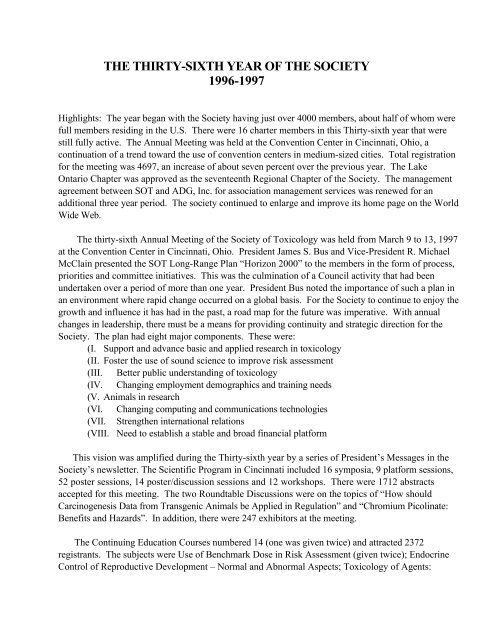SOCIETY O. TOXICOLOGY HISTORY - Society of Toxicology
SOCIETY O. TOXICOLOGY HISTORY - Society of Toxicology
SOCIETY O. TOXICOLOGY HISTORY - Society of Toxicology
Create successful ePaper yourself
Turn your PDF publications into a flip-book with our unique Google optimized e-Paper software.
THE THIRTY-SIXTH YEAR OF THE <strong>SOCIETY</strong><br />
1996-1997<br />
Highlights: The year began with the <strong>Society</strong> having just over 4000 members, about half <strong>of</strong> whom were<br />
full members residing in the U.S. There were 16 charter members in this Thirty-sixth year that were<br />
still fully active. The Annual Meeting was held at the Convention Center in Cincinnati, Ohio, a<br />
continuation <strong>of</strong> a trend toward the use <strong>of</strong> convention centers in medium-sized cities. Total registration<br />
for the meeting was 4697, an increase <strong>of</strong> about seven percent over the previous year. The Lake<br />
Ontario Chapter was approved as the seventeenth Regional Chapter <strong>of</strong> the <strong>Society</strong>. The management<br />
agreement between SOT and ADG, Inc. for association management services was renewed for an<br />
additional three year period. The society continued to enlarge and improve its home page on the World<br />
Wide Web.<br />
The thirty-sixth Annual Meeting <strong>of</strong> the <strong>Society</strong> <strong>of</strong> <strong>Toxicology</strong> was held from March 9 to 13, 1997<br />
at the Convention Center in Cincinnati, Ohio. President James S. Bus and Vice-President R. Michael<br />
McClain presented the SOT Long-Range Plan “Horizon 2000” to the members in the form <strong>of</strong> process,<br />
priorities and committee initiatives. This was the culmination <strong>of</strong> a Council activity that had been<br />
undertaken over a period <strong>of</strong> more than one year. President Bus noted the importance <strong>of</strong> such a plan in<br />
an environment where rapid change occurred on a global basis. For the <strong>Society</strong> to continue to enjoy the<br />
growth and influence it has had in the past, a road map for the future was imperative. With annual<br />
changes in leadership, there must be a means for providing continuity and strategic direction for the<br />
<strong>Society</strong>. The plan had eight major components. These were:<br />
(I. Support and advance basic and applied research in toxicology<br />
(II. Foster the use <strong>of</strong> sound science to improve risk assessment<br />
(III. Better public understanding <strong>of</strong> toxicology<br />
(IV. Changing employment demographics and training needs<br />
(V. Animals in research<br />
(VI. Changing computing and communications technologies<br />
(VII. Strengthen international relations<br />
(VIII. Need to establish a stable and broad financial platform<br />
This vision was amplified during the Thirty-sixth year by a series <strong>of</strong> President’s Messages in the<br />
<strong>Society</strong>’s newsletter. The Scientific Program in Cincinnati included 16 symposia, 9 platform sessions,<br />
52 poster sessions, 14 poster/discussion sessions and 12 workshops. There were 1712 abstracts<br />
accepted for this meeting. The two Roundtable Discussions were on the topics <strong>of</strong> “How should<br />
Carcinogenesis Data from Transgenic Animals be Applied in Regulation” and “Chromium Picolinate:<br />
Benefits and Hazards”. In addition, there were 247 exhibitors at the meeting.<br />
The Continuing Education Courses numbered 14 (one was given twice) and attracted 2372<br />
registrants. The subjects were Use <strong>of</strong> Benchmark Dose in Risk Assessment (given twice); Endocrine<br />
Control <strong>of</strong> Reproductive Development – Normal and Abnormal Aspects; <strong>Toxicology</strong> <strong>of</strong> Agents:
















